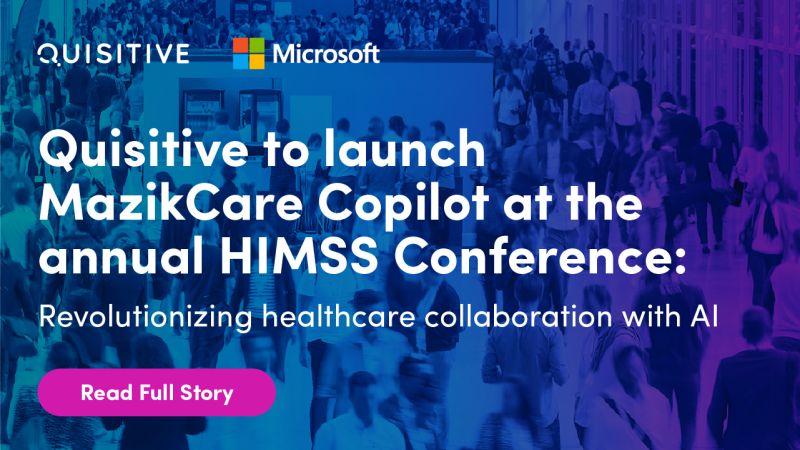As healthcare providers increasingly focus on improving patient care, they need to find innovative and streamlined solutions for four core areas of change – system modernization, supply chain, virtual care, and data insights. These topics are all covered in this blog, which summarizes the key takeaways from the recent Healthcare Technology Summit hosted by Quisitive.
System Modernization
It’s vital for healthcare systems to address three important business drivers in order to meet new challenges and offer advanced patient care at competitive prices. Medical technology innovation, strategic technology transformation, and structural change must be on the radar of all health systems.
Medical Technology Innovation: New therapeutic, diagnostic and care innovation models are arising from the move toward digitalization, medical innovations, the advancement of science, and new technology entrants. Providers must adapt and align to make sure they are ready to deliver in these areas.
Strategic Technology Transformation: Major changes are on the way concerning how the industry uses technology, arising from applied innovation, disjointed user experiences, and disruption in technology standards and architectural principles. As a result, systems need to innovate with the cloud, data analytics, and artificial intelligence.
Structural Change: Healthcare is no longer confined within the four walls of a hospital. Retailers, digital giants and digital natives continue to expand their reach into care delivery with virtual care, wearable integration, and primary care or chronic condition services — putting pressure on providers to accelerate competitive offerings and partnerships. New competition can be great for consumers, but healthcare systems must adapt and drive change to meet patient needs in the digital age.
Supply Chain
Supply chain operations represent a huge opportunity to trim costs while improving patient outcomes. Given that supply chain costs account for 37.5% of total patient care expenses, just behind labor, it comes as no surprise that there is a strong movement to include the supply chain in efforts to reduce costs and enhance the patient care experience.
For example, it is common for clinical staff to spend large amounts of time managing inventory on the floor and conducting other supply chain-oriented tasks that take away from time with patients. By installing new technologies, such as an ERP system that automates and streamlines supply chain processes, El Rio Community Health Center was able to return over 5,000 hours a year of clinical time to caregiving activities. In some cases, nurses were spending up to 20 hours a week on supply chain tasks such as inventory control and order procurement.
“The importance of being in tune with your supply chain is [crucial] to ensure that we can always provide the best care.”
– Tim Snowball, Procurement Director for El Rio Community Health Center
Investing in a dynamic ERP system has brought numerous benefits to El Rio, including improved visibility into inventory levels and the ability to rapidly ship orders from its warehouse, often within hours of receiving an order. In addition, El Rio has full insight into PO confirmations and automated reorder levels throughout its warehouse.
When pursuing these improvements, it is imperative for health systems to develop KPIs for specific supply chain management tasks. A few key ones include:
- Supply expenses as a % of net revenue
- Spend under management
- Inventory turns
- Supply FTEs per 1 million total non-labor supply expense
- Expired products as a % of total on-hand products in inventory
Virtual Care
In the age of digital healthcare transformation, consumers are in the driver’s seat. Consumer-centric patterns emerged before the pandemic, but the global health crisis caused a paradigm shift from the traditional patient experience to the world of virtual care, where consumers have more choice. For example, the pandemic accelerated the movement to health clinics provided by retailers like CVS, Walgreens, even Walmart. When traditional healthcare systems had to limit appointments during the pandemic to protect staff and patients, these retail health offerings grew exponentially. Many consumers already have existing relationships with these retail providers. Healthcare systems recognize this trend. Because they are not in a position to compete on price point, some systems are collaborating with retail providers by acknowledging that they represent a strong alternative for select urgent care services, but not for everything. In those cases, systems are utilizing referrals.
Healthcare systems need to consider that virtual care provides an opportunity to expand their customer base into at-risk and underserviced regions. Ideally, virtual care increases access to care for everyone. However, issues around health equity prior to the pandemic only increased during the health crisis.
“Health systems must ensure that virtual health is a tool for good … and doesn’t actually increase healthcare inequalities.”
– Antoinette Toni Thomas, Chief Experience Officer, US Health & Public Sector Industries, Microsoft
Healthcare systems can address this by evaluating patient populations to determine how many customers have access to laptops, mobile phones, and the Internet. It is also crucial to evaluate the availability of 5G networks in your service area, as virtual health visits perform best over 5G. Providers and payors can utilize data insights to better understand populations leading to improved virtual healthcare offerings and outcomes.
Data Insights
Data is a crucial tool when it comes to the growing focus that healthcare providers place on patient satisfaction, physician engagement, and quality of care. The use of data can have a major impact on many areas, including:
- Increasing patient care plan adherence
- Reducing patient no-show rates
- Determining propensity to pay
When it comes to patient no-shows, a missed appointment represents less of an operational challenge than it does an actual quality of care challenge. Initial visits and follow-up visits are critical aspects of the care chain to ensure that patients adhere to scheduled treatments. Data analysis tools can help to identify the most significant factors driving patient no-show rates and can reduce the frequency of these events by enabling new approaches to improve patient communication. Analyzing demographic variables such as insurance type, geographic location, and the time of day of an appointment, for example, can help to determine which patients respond best to certain kinds of messaging, thereby helping to reduce missed appointments.
“Data analysis can identify factors that may cause some patients to avoid care because of an inability to pay.”
– Robert Carek, Project Executive, Director Global Solution Development at Quisitive
Similarly, data can have a major impact in analyzing patient demographics to determine their propensity to pay. Non-payment of healthcare costs is a significant factor in most healthcare system’s bottom line, usually because of the client’s inability to pay, or because of fraudulent use of insurance. In turn, solutions can be put into place to work with this population. It is vital for patients to get the treatments they need, and providers should utilize data to identify patterns that indicate which patients are more likely to face challenges when it comes to paying their bill.
Quisitive’s Healthcare Technology Summit emphasized that data is a company’s most important asset, and is often underutilized. Our healthcare solution, MazikCare, provides powerful access to real-time data – leading to more informed healthcare decisions and improved patient care.
Listen to the recording of the Healthcare Technology Summit or for more information, Contact Us.

;)


